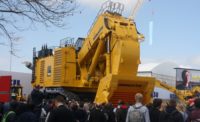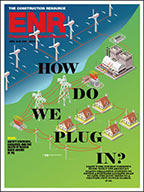Komatsu’s Hybrid Excavator Takes First Stab at U.S. Market
Komatsu Ltd. is testing the North American equipment market with its new PC200LC-8 Hybrid Excavator, a lean, green digging machine that has sold more than 700 times in Asia since production began 19 months ago.

The 22-ton excavator, the first hybrid of its kind in the U.S., was put to work on March 11 at the Port of Los Angeles. “We are targeting the excavator to customers who are after a green image and who have a green initiative as part of their corporate principals,” says Armando Najera, excavator product manager for Rolling Meadows, Ill.-based Komatsu America Corp. “This is a machine that is going to help meet the emissions goals of several regions in the U.S.”
The hybrid model, one of nine on a U.S. road show, is between 25% and 40% more fuel-efficient than the standard PC200LC-8 hydraulic excavator, says Japan-based Komatsu Ltd. In one hour of operation, the hybrid model emits up to 22 lb less carbon dioxide. Mary Nichols, chairwoman of the California Air Resources Board, says machines like this are helping transform the state’s trucking and construction industries. “We’re actually cleaning the air one piece of equipment at a time, and the [hybrid excavator] and others are going to help us meet our goals of energy-efficiency and diversification of the fuel supply,” she says.
Dan McGrew, vice president of business development with Brea, Calif.-based Griffith Co., says the hybrid’s low CO2 emissions could help contractors keep up with demanding regulations. “CARB has come up with pretty stringent air requirements that have put a lot of grading contractors out of business in California,” says McGrew, whose general-contracting company is using the hybrid on the $48-million Port of Los Angeles project. “But the Komatsu hybrid excavator is wonderful because it shows if we let the manufacturers come up with the solutions, then we can incorporate them into our fleet and let the life cycle of our older pieces work themselves out.”
With the new hybrid technology comes added costs. Najera says, unlike a non-hybrid model, the machine sells at a 50% premium, or about $225,000, a figure the current market “won’t bear.” Fuel prices and machine hours are main factors in the payback equation.
“In China and Japan, customers have been able to afford the 50% premium because of high fuel costs and because they run the machines about 2,000 hours a year,” Najera says. Komatsu is lobbying CARB to create clean-air grants and other funding to help offset the extra costs. Likewise, Komatsu rival Caterpillar Inc. began producing a hybrid bulldozer last year.
The excavator was introduced to the Japanese market in June 2008, and it was released in China last August. Komatsu is making about 100 per month in Tokyo and has sold more than 700 units throughout Asia. Komatsu is looking to sell an additional 500 machines this year in China. It is currently not for sale in the U.S., but eventually Komatsu plans to bring it here and make hybrids in other sizes and classes.
How It Works
Instead of a diesel engine for power and a hydraulic motor to turn the superstructure, the hybrid employs a diesel engine, an electric-swing motor, a generator, a capacitor and pumps. “This is a hybrid by every definition,” says Najera. “It recuperates energy that would otherwise go unused, stores it and makes it available to do work.” As the swinging superstructure slows down, kinetic energy converts to electricity, which is sent through an inverter and then captured by a capacitor.
“Because 99% of excavators are swinging in most applications, we decided we could gather [energy] similar to a hybrid car,” says Najera. Unlike a car battery that depends on a chemical reaction, the capacitor provides the burst of power needed for construction, Komatsu says.
The generator/motor is located between the engine and the hydraulic pumps. It can charge the capacitor during periods of downtime, and it can receive power from the capacitor for engine assist, determined by a power controller. Besides innovations under the hood, the hybrid sports a modern interior. Viscous cab dampers reduce vibration; a 7-in. LCD screen provides easy-to-read gauges; a rearview camera displays hard-to-see work zones, and a wireless tracker keeps tabs on the machine’s whereabouts.
The hybrid drive allows Komatsu to scale down the diesel engine, though the company claims that net power actually increases. The non-hybrid excavator runs a 6.7-liter, six-cylinder Komatsu turbo-diesel rated at 148 horsepower, while the hybrid model uses a 4.5L, four-cylinder rated at 138 hp. Najera says these numbers are misleading because the hybrid powertrain offers up to 200 hp. “The whole idea of the fuel savings is that the machine is smart and senses when there is a demand, and that’s when it kicks up and adds power to the system,” he says.
Komatsu attributes 75% of the fuel savings to the hybrid drive and the balance to an engine-management system it calls “low-speed matching,” which cycles the diesel up and down. “The engine starts off with a very low idle of 700 rpm —very low compared to a normal machine, which is between 950 and 1,050 rpm,” Najera says. At first, operators say, the change is unnerving. “The idle [on the hybrid] goes up and down like it is starving for fuel, but it’s not,” says Silverio Palacios, an operator with Irvine, Calif.-based Savala Equipment Rentals.
Getting used to the new machine, Palacios says, is a “feel thing.” As soon as an operator “gets rid of the concept that the faster [the hybrid] idles, the more powerful it is,” it takes about an hour to become comfortable in the driver’s seat. “It’s just the way you interpret it, and you have to ignore that,” he says.



